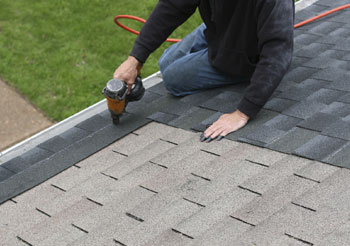
The ABC’s of Roofing
What You Need to Know About Your Roof
By Ed Williams / Published Nov 2015

Since the roof of the building is oftentimes out of sight, it is also frequently out of mind. This can lead to expensive trouble. There are dozens of roof systems on the market today, and every contractor in the Yellow Pages has a favorite. How are you as a condominium owner or board member supposed to know what is right for your roof? Do you need a new roof, or do you just need preventive maintenance? While all those questions can’t be answered within the confines of this article, there is certainly sound advice to be given to help in those decisions.
Normally, condominiums have reserves for big ticket items such as roofing. The cost of a new roof has increased throughout the years, and with the new codes that came in this past June, some roofs can be even more expensive because of the energy requirements. That is why it is very important to have a plan both to extend the life of your roof and to know what to do when the roof needs replacing. Let’s hit some of the highlights.
Picking Your Team
Do your board members have any expertise in construction and roofing specifically? You have a fiduciary responsibility to your owners to hire outside expertise where necessary. If you do need to hire a roof consultant, there is an organization called RCI (www.rci-online.org) that can provide you with a list of consultants in your area. There are also some engineers that specialize in roofing work, but generally speaking, roofing is not what engineers specialize in. There should also be a point person on the team to coordinate on behalf of the owner and the rest of the team.
Budget
Hopefully you’ve had regular updates and your budget reserves are in good order. A good consultant will be able to tell you, first of all if you need a new roof or if you need repairs, and should be able to give you construction budgets for both. If your reserves are not adequate to do what needs to be done, then one of two things needs to happen. Your consultant can advise you on the feasibility of extending the life of your current roof and associated cost or you can have a special assessment. From past experience, the latter option is widely unpopular. There is a third option, which is that most banks will loan you the money with good terms so that your owners can pay monthly payments rather than a lump sum. One thing to take away from this article is what I tell every board I talk to, “if you can’t afford to do it right, postpone until you can!”
Roofing Industry Terminology
Everyone in this industry and other industries has their own terms and lingo unique to their industry. In addition, people love to use unique words to show how smart they are. I submit to you that we’re not very smart if we talk to you in a language you cannot understand. Let’s go over a few of those important terms:
Ed Williams
Registered Roof Consultant
Ed Williams has more than 40 years of experience in the roof consulting and waterproofing industry and has held the title of Registered Roof Consultant since 1995. He is trained in the design and installation of all types of roofing. Experience includes analysis, testing, and design of all systems including single-ply, built-up roofing, shingles, modified, slate, tile, polyurethane foam, and metal. For more information, call Ed Williams Roof Consultants at (772) 335-5832, e-mail Ed@EdWilliamsRoofConsultants.com, or visit www.edwilliamsroofconsultants.com.
Membrane
This signifies the type of waterproofing material that your roof is comprised of. For many years, the membrane has been based on asphalt products. During the oil shortages in the ‘70s when asphalt prices skyrocketed, many non-asphalt base materials became popular. Some of the newer products are lumped into a grouping called single-ply membranes such as EPDM, PVC, and TPO. TPO is one of the more popular single-ply membranes being used in Florida today. Polyurethane foam (PUF) is another popular choice in Florida and has a variety of coatings and warranties to offer.
Performance and Payment Bond
This is something that you would want your roofing contractor to be able to provide. It is basically an insurance policy that ensures the contract. This will ensure that if the contractor goes out of business prior to completing your project, then the bonding company will finish the job. It will also pay any bills that the contractor did not pay in the event that he goes out of business. And, it will honor the warranty terms in the event he goes out of business while the warranty is still in effect. This is a very important document because over the past 10 years lots of contractors have come and gone.
 Reroof or Recover
Reroof or Recover
To reroof means tearing off all the existing roofing materials down to the substrate. To recover means to leave at least a portion of the existing roof in place and install a new roof over it. There are many things that enter into this decision, such as the compatibility of the selected new roof and the existing roof, the weight of the combined two roofs, and whether or not the components of the existing roof to remain are dry.
Warranty
The warranty is issued by the manufacturer and covers defects in materials and workmanship usually for a period of 10–20 years. In addition, it is normal to see a requirement from the manufacturer that the roofing contractor provide a two-year workmanship warranty. Two years is when most workmanship items will have shown up. Included in the warranty you may see the term NDL. This stands for no dollar limit and essentially means that the warranty is not prorated over the 20 years, but is worth just as much in the 20th year as the first year. This is an extremely important piece of paper and should be treated as such. If your roof cost $300,000, then that piece of paper is potentially worth $300,000. This along with all other documents generated by the contract should be placed in a three-ring binder and kept in a place where it can be passed along to successive boards. While on the subject of warranties, one of the comments that is too often heard is, “I have a 20 year warranty; I don’t need to do maintenance.” Rest assured that a warranty is not a maintenance contract, and there will be specific language in the warranty describing your responsibilities.
So, it has been determined by your team that you need a new roof. You have specifications provided by your consultant, you have the funds in hand, and you’re ready to go out for bids. Your consultant can assist you in prequalifying contractors and inviting them to bid on your project. Once the low bidder is selected, do you automatically go with the low bidder? Not so fast. He needs to be called in for an interview with the team and the following questions need to be asked and answered satisfactorily:
- How long have you been in business? I would suggest a minimum of five years and hopefully the principal has even more experience.
- Are you approved by the manufacturer to install this roof system and can you provide us a couple of references on recent jobs?
- Can you furnish a performance and payment bond? If so, what is your rate? The rate should not exceed 2.5 percent, and if it does, then it means that the bonding company has some reason to be wary.
- How long will the project take? How much storage space do you need? How will you protect my building in the event of a sudden rain storm? How will you protect our parking lots and building surfaces? When will you start?
In summary, a roofing project is very important to your building and there are many steps in completing a project successfully.
- Assemble a team that rounds out the in-house experience.
- Determine the need to reroof or repair.
- Are the reserves adequate for what needs to be done?
- Do you understand everything? Don’t be afraid to ask questions.
- Have a clearly defined scope for bidders.
- Insist on a performance and payment bond.
- Interview low bidders.
- Arrange for periodic inspections during construction.
- Do not pay the last 10 percent until all warranties and paperwork are complete.
- Institute an annual maintenance inspection.

